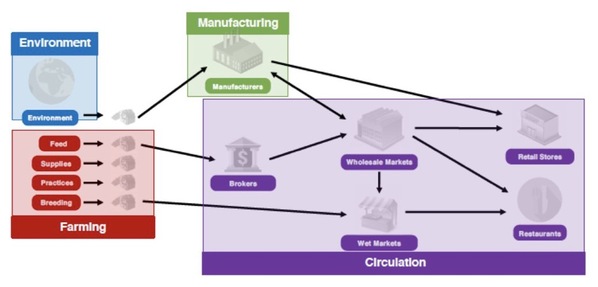According to the WHO's 'Estimates of the Global Burden of Foodborne Diseases' report in 2015, approximately 600 million people (almost one in 10) worldwide fall ill from eating contaminated food annually; about 420,000 of these cases result in death each year. Moreover, the number of cases of illness caused by eating contaminated food continues to grow.
As a result of globalized supply chains, food crosses numerous jurisdictions across many different interventions and stages, including processing, storage, and sales. How can we effectively manage food safety and reduce adulteration risk in a complex environment?
The research team led by Prof. ZHOU Weihua from the Zhejiang University School of Management and his collaborators from Massachusetts Institute of Technology address this global challenge to human life and health through in-depth research on systematic risk management of China's food supply chains.
Their research, entitled "Testing at the Source: Analytics-Enabled Risk-Based Sampling of Food Supply Chains in China was published in Management Science. In addition, Prof. ZHOU's project earned him Zhejiang University's 2021 Academic Innovation Award.
The research team has taken a holistic view of China's food safety risk management and the operation of supply chains, exploring strategies to effectively improve food safety and reduce the risk of adulteration. The research was undertaken in the context of China's food supply chain, which exhibits a notably decentralized and complex organizational structure in comparison to more developed food supply chains overseas.
Agricultural production and upstream operations are decentralized and fragmented, while midstream distribution is characterized by multi-step systems that entail significant losses. To reach consumers, agricultural products transit through brokers, wholesale markets at their place of origin, secondary wholesalers, and retail-facing wholesalers before reaching wet markets, supermarkets, and other consumer channels. In addition, there are numerous downstream sales channels, including hypermarkets, supermarkets, wet markets, and online retailers. These multi-step systems present challenges to effectively managing food safety in China.

The aquatic products supply chain and the four risk sources
Addressing these problems, Prof. Zhou and his team leveraged data from 89,970 tests on aquatic food products, extracted from a bespoke dataset comprising 2.6 million food safety tests conducted by the China Food and Drug Administration, now incorporated into the State Administration for Market Regulation (CFDA). This integrated and structured dataset enabled innovative analysis to identify sources of risk from adulterated aquatic food products.
Based on the analysis of this unique dataset, the researchers have garnered a series of key insights.
In particular, the research highlighted potential gaps in current CFDA testing allocations based on supply chain location, which results in a heavy focus on retail and supermarkets. Consequently, the analysis suggests under-sampling of high-risk components of the supply chain, such as wholesale and wet markets.
Based on their findings, Prof. Zhou's team has proposed a risk-based regulatory resource allocation strategy to promote enhanced cooperation between government, manufacturers, and consumers to provide comprehensive food safety assurances.
This research has considerable relevance to effective food safety supervision. Food safety impacts the health of every Chinese citizen and society as a whole. Yet, despite investing billions in food safety sampling inspections annually, the scale of China's food market has meant that these inspections remain insufficient. Accordingly, it is vital to improve testing efficiency and the efficacy of regulatory resources. The supply chain analytics tool developed by Prof. Zhou's team could help the government conduct efficient food safety sampling inspections, effectively allocate valuable resources, and formulate streamlined regulatory strategies to improve food safety nationwide.
Source: School of Management, Zhejiang University






